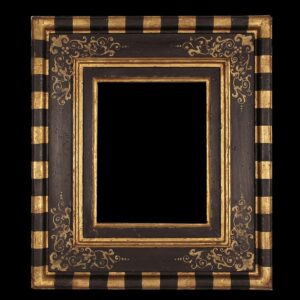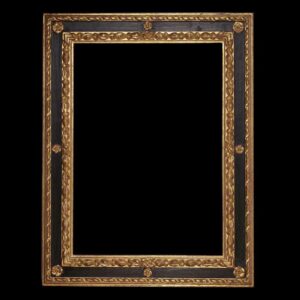Black and Gold Picture Frames
Black and gold picture frames appeared a long time ago. In the 1300s, during the Gothic style, gilders used black lacquer on tabernacles. So, gold and black wall frames, since their first appearance, became recurring finishing models.
Gold leaf and black paint together are a perfect union. Indeed, the gilded carvings stand out better alongside the flat black lacquered surfaces of the frames. Notice that when the frames are completely gilded, their ornates don’t stand out so well. In fact, at a first glance, one could not notice certain ornamentations. On the other hand, when black paint is applied, suddenly it creates a nice contrast with the gold leaf.
Black and Gold wall Frames styles
After the first examples of tabernacles, polyptychs, diptychs, and triptychs for church paintings, Renaissance craftsmen realized many black and gold wall frames. The traditional Cassetta profiles of the 1500s are often decorated with black paint and gold leaf. Gilders would use the black lacquer as a background on the typical flat central surfaces. This way the “candelabra” ornate applied above would stand out in all its magnificence.
Follow a couple of links below to see two examples of Renaissance black and gold wall frames. The first is a Cassetta frame with carved gilded ornates on top of black lacquer. The second is a Siena frame with painted gold on the black central surface.
Black and Gold wall Frames of the 1600s
Gilders of the Baroque era made consistent use of black paint on frames. As you probably know, the Baroque style stands out for very rich decorations. Even though 17th-century frames tend to be large and overloaded with carvings, there are good examples of balanced frames. Indeed, black lacquer helps a lot to mitigate the excess of ornamentations on Baroque models.
Italy and Spain realized astonishing examples of black and gold ornate picture frames. Especially South Italy, which was under the Spanish government, accomplished the production of famous style frames. Roman frames as well, with the Salvator Rosa model, became famous.
See below a couple of frames of the 1600s in gold leaf and black paint:
Salvator Rosa frame
Spanish frame
As you’ve noticed from the links above, Roman models are more sophisticated. They have more carvings on their profiles. On the other hand, Spanish gilders simplified quite a lot of the same types of frames. Even the Neapolitan artisans used the black lacquer similarly to Spanish gilders. Probably, the Spanish craftsmen got influenced by Naples styles. Remember that South Italy was under the Spanish crown.
Dutch Black and Gold leaf picture Frames
Dutch frames deserve an entire section of this article. Even though the majority of Flemish frames are completely black, still, there is a typical model that we want to share here. Follow the link below to see a Dutch black and gold leaf picture frame: Flemish frame.
Notice that a single line of gold along the inner frame lights up the entire black structure. The beauty of this model is due precisely to that bit of gold leaf. On one hand, the black lacquer maintains the structure light. On the other hand, a spot of gold enriches a very dark structure.
The following link shows you the same profile without gold: Flemish black frame. Of course, it’s still beautiful. Unfortunately, it is not suitable for all types of paintings. It could be excellent for quite dark Dutch paintings. But what about a bright Italian Renaissance painting full of light colors? We don’t think that would be the best choice.
Venetian black and gold leaf picture frames
Venetian frames are also a valid example of black and gold leaf picture frames. Gilders, in Venice, made abundant use of gold and lacquer. Even though Venetian craftsmen preferred green paint, there are a few examples of black and gold antique picture frames from Venice.
See below a couple of links related to 18th century Venice style frames:
Black and gold Venetian frame
Black and gold Venetian ornate frame
You can tell they come from Venice because of the typical profile. The external side of it is lower than the inner one. If you saw the sketch beside them you got the idea. Even the cartouches of the last one reveal the clear provenance from Venice.
Black and gold ornate picture frames from the 1800s
During the 1800s European artisans realized plenty of black and gold ornate picture frames. Among the most productive, French craftsmen had an important role. Indeed, French black and gold antique picture frames are astonishing.
A couple of decades ago, we had the chance to restore an original Empire French frame. After the long work of restoring, we decided to realize a replica of that model. Follow this link to see what we’re talking about: Empire picture frame #108.
We believe it to be astonishing for two reasons. First, its shape is very worked, a bit heavy perhaps, but very balanced at the same time. Its width is 10 cms and the depth is almost 7 cms. On one hand, you get a pretty heavy structure if you put it around a painting. On the other hand, it looks tremendously light because of the black paint.
Our cod. 108 shows how black and gold antique picture frames can be big and light at the same time. This is the perfect model to frame dark and bigger artworks of the 19th century.
Black and Gold Frames light up paintings
Can you imagine a very dark frame and a bright colorful painting together? Since we’re engaged with reproduction frames, we love to match dark paintings with dark frames. A search for the contrast between the two is not the right solution. We strongly believe that the tone and the patina of a frame should be similar to its painting.
The contrast indeed comes in handy if you want to make stand out one between two objects. But what about if you’d focus just on the frame instead of the painting? For this reason, the risk is not worthy enough. And rigorously we recommend believing in our proven rule.
So, after a century of experience, we think that black and gold antique picture frames are suitable for dark artworks. A question may arise now. Dark alongside dark doesn’t create a black spot? No, because the artwork is never darker than a black frame. Black and gold antique picture frames are always darker than a painting. Consequently, the painting, which is brighter because of colors, is going always to stand out.











